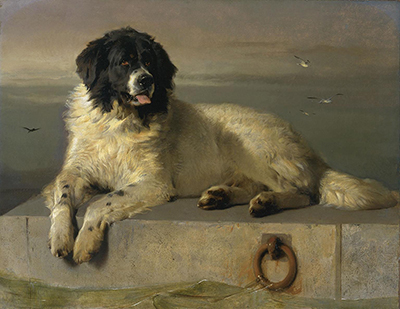Exhibited in 1838, A Distinguished Member of the Humane Society, oil on canvas painting depicts a well-fed black and white dog lying on a quay. The dog is seen facing the left side with his forepaws hanging over the edge.
Landseer was the Shakespeare of animal paintings, and in portraits like this one, he was good at bringing out the rise of the evolutionary thinking between people and dogs. By the time this portrait was being exhibited in 1838 at the Royal Academy, the British people had begun to view dogs differently. It was in the 19th century that the British law started to protect animals. In this painting is an image of Newfoundland, Bob allegedly rescued from a shipwreck on the coast. Bob had found his way to London’s waterfront where he saved many people from drowning for what is said to be fourteen years. This caused him to be made a distinguished member of the Royal Humane Society, a position that got him free food and a medal.
By the time Landseer decided to paint him, he had long disappeared, and so, he decided to bring a different perspective into the model. He used a dog named Paul Pry, who had the same similarities as Bob in terms of colour and stature. This artwork emphasizes soft-eyes and a heaven-ward cast expression, an attitude reserved for saints in pieces that are related to religion. The dog looks calm and dignified, with a relaxed posture, which is believed to be a symbol of reassurance. The sky behind him is somewhat golden and light in colour, suggesting radiance and hope.
This painting portrays intricate details that magnify the art of life. The immaculate details almost make the image look like a photograph, with the background giving the picture a mysterious feeling. For instance, the clouds look gloomy, giving an impression of an oncoming storm. The water near the paws also seems a little murky, bringing out a realistic visual.
The background is somehow dull, but the dog seems comfortable and relaxed, aware of its surroundings. Further, you will also notice birds against the sky, with the dog markings highlighted and his head standing out. The strokes of the painting cause the fur to look soft and fuzzy like you could almost touch and feel it. Throughout the portrait, you will notice that the brushstrokes are smooth and bold.
In making the dog’s expression nearly human, Landseer is believed to make an argument for consideration during the Victorian period, when the animal rights movement was still in its early stages. In the 19th century, this painting resonated with animal advocacy groups and animal lovers powerfully. Overall, the portrait has a naturalistic look, with the dog as the centre of attention.




